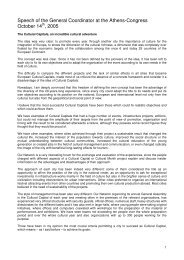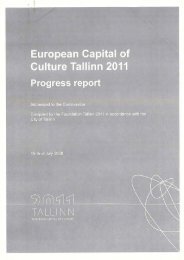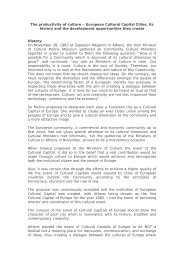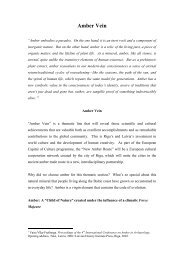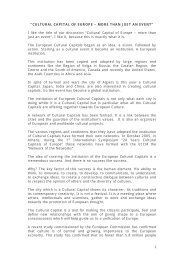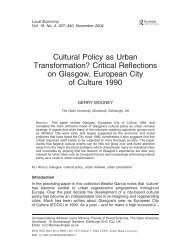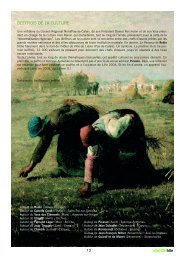patras 2006 - ecoc-doc-athens
patras 2006 - ecoc-doc-athens
patras 2006 - ecoc-doc-athens
You also want an ePaper? Increase the reach of your titles
YUMPU automatically turns print PDFs into web optimized ePapers that Google loves.
ΣΗΜΕΙΩΣΕΙΣ ΓΙΑ ΤΑ ΕΡΓΑ<br />
Κείµενα µεταπτυχιακών φοιτητών του Τµήµατος Θεατρικών<br />
Σπουδών του Πανεπιστηµίου Πάτρας<br />
Χοηφόροι του Αισχύλου<br />
Οι Χοηφόροι είναι το δεύτερο δράµα της Ορέστειας<br />
(458 π.Χ.), της µοναδικής τριλογίας που σώθηκε από<br />
το σύνολο της δραµατικής παραγωγής των αρχαίων<br />
Ελλήνων τραγικών. Ο Αισχύλος δραµατοποίησε τα<br />
γεγονότα που ακολούθησαν την επιστροφή του<br />
Αγαµέµνονα από τον Τρωικό Πόλεµο στο οµώνυµο<br />
πρώτο δράµα της τριλογίας. Στις Χοηφόρους τα<br />
γεγονότα επαναλαµβάνονται, µε απόλυτη σχεδόν<br />
αντιστοιχία, µε την επιστροφή και την εκδίκηση του<br />
Ορέστη για το φόνο του πατέρα του Αγαµέµνονα.<br />
Το πρώτο µέρος του δράµατος, µε τις επικλήσεις, τον<br />
κοµµό και τις προσφορές (χοές) για τον εξευµενισµό<br />
του πνεύµατος του νεκρού, είναι µια µεγαλειώδης<br />
σύνθεση λόγου, µουσικής και όρχησης στο πλαίσιο της<br />
θρησκευτικής τελετουργίας, που δίνει στην τραγωδία το<br />
όνοµά της. Στο δεύτερο µισό του δράµατος η τραγωδία<br />
του οίκου των Ατρειδών οδηγείται στην κορύφωσή<br />
της µε την µητροκτονία. Η Κλυταιµνήστρα, που ήταν<br />
ο θύτης στον Αγαµέµνονα, γίνεται τώρα το θύµα. Ωστόσο,<br />
η επιστροφή του Ορέστη καταλήγει σε αδιέξοδο, καθώς<br />
η δολοφονία της Κλυταιµνήστρας αποτελεί ένα µιαρό<br />
έγκληµα και η εκδίκηση του ήρωα συνεπάγεται<br />
ταυτόχρονα και τη δική του ενοχή και τιµωρία.<br />
Ο Ορέστης ενεργεί µεν σύµφωνα µε την εντολή του<br />
Απόλλωνα, αλλά δεν είναι απλά ένα όργανο των θεών,<br />
ούτε µόνο το θύµα της κληρονοµικής κατάρας: αυτό<br />
που αναγκάζεται να πράξει, υποκύπτοντας στην επιταγή<br />
της µοίρας, ταυτίζεται τελικά και µε τη δική του βούληση.<br />
Στο τέλος της τραγωδίας ο Ορέστης αποχωρεί<br />
κυνηγηµένος από τις Ερινύες. Η αίσθηση του χάους,<br />
τόσο στο µυαλό του ήρωα όσο και στην πόλη του<br />
Άργους, η ερηµιά και το αδιέξοδο, είναι οι τελικές<br />
εικόνες που αποµένουν στο θεατή. Πρόκειται για µια<br />
τραγωδία χωρίς κάθαρση, σκοτεινή και εφιαλτική.<br />
Είναι άλλωστε η µοναδική σωζόµενη τραγωδία που<br />
τελειώνει µε ένα ερώτηµα. Ο αιώνιος νόµος της ∆ίκης,<br />
που παραδοσιακά εκπληρωνόταν στο πνεύµα της<br />
ανταπόδοσης, αποδεικνύεται ανεπαρκής. Η ταύτιση του<br />
Ορέστη και της Κλυταιµνήστρας και το γεγονός ότι<br />
ο ίδιος πρέπει στις Χοηφόρους να επαναλάβει όσα και<br />
εκείνη έπραξε, εκφράζουν την αποτυχία του συστήµατος<br />
δικαιοσύνης που ίσχυε έως τότε. Η εξισορρόπηση του<br />
θεατή και η κάθαρση θα πραγµατοποιηθούν µόνο<br />
στο τρίτο δράµα της τριλογίας, τις Ευµενίδες, όπου θα<br />
πραγµατοποιηθεί και η µετάβαση από τη µυθολογική<br />
δικαιοσύνη στην ιστορική δικαιοσύνη.<br />
Μαρία Ρενιέρη<br />
Οιδίπους Αντί-Οιδίπους του Γιώργου Βέλτσου<br />
Το Οιδίπους Αντί-Οιδίπους είναι το τέταρτο θεατρικό έργο<br />
του Γιώργου Βέλτσου.∆ιαβάστηκε για πρώτη φορά<br />
ενώπιον κοινού από τον ίδιο το συγγραφέα στους<br />
∆ελφούς, στο πλαίσιο της 12ης ∆ιεθνούς Συνάντησης<br />
Αρχαίου Ελληνικού ∆ράµατος, υπό τις σκηνοθετικές οδηγίες του<br />
Βασίλη Παπαβασιλείου.<br />
Με το συγκεκριµένο έργο του ο Γιώργος Βέλτσος εντάσσεται στην<br />
κατηγορία των συγγραφέων που διατυπώνουν µια διαφορετική<br />
ερµηνεία του µύθου του Οιδίποδα.<br />
Ο µύθος υφίσταται µεταλλάξεις, τόσο σε επίπεδο δοµής όσο και σε<br />
επίπεδο µορφής, και προβάλλει τα νέα οράµατα του λογοτέχνη.<br />
Ο συγγραφέας προτείνει νέες διαδικασίες πρόσληψης του αρχαίου<br />
µύθου µέσω της παρανάγνωσής του και «προκαλεί» έτσι τον<br />
διαµορφωµένο «ορίζοντα προσδοκιών» του κοινού.<br />
Ο Οιδίπους του Γιώργου Βέλτσου παραπέµπει εµφανώς στον<br />
Οιδίποδα του Σοφοκλή. Θα λέγαµε ότι δικαιώνεται η σύγχρονη<br />
θεωρία της διακειµενικότητας, που αντιλαµβάνεται το κείµενο ως<br />
γραφή µπροστά στον καθρέφτη που αντανακλά ένα άλλο κείµενο,<br />
καθώς ο συγγραφέας αποδέχεται τη συµβολική και φιλοσοφική<br />
σηµασία του µύθου του Οιδίποδα και υφαίνει το παράδοξο<br />
του ήρωα. Αναγνωρίζει κανείς στο κεντρικό δραµατικό πρόσωπο<br />
έναν παραλλαγµένο Οιδίποδα, που προχωρεί µέσα από<br />
το αντικαθρέφτισµα του αντιδραµατικού προσωπείου προς<br />
µια διαλογική αποκάλυψη του «άλλου εαυτού» του.<br />
Η νέα Σφίγγα ξεκάθαρα δίνει την ταυτότητα του νέου Οιδίποδα:<br />
«Αλλά ανυπόδητος εσύ όσο κι αν τρύπωσες στη φαντασία των πραγµάτων<br />
µε διάνοια σαν τον σοφό [… ] στάζεις αρρώστια, Οιδίποδα».<br />
Το έργο χαρακτηρίζεται από το συγγραφέα ως «ένα έργο της<br />
προσφυγιάς» και ο ίδιος το ονοµάζει «ποίηµα». Αγγίζοντας τη<br />
µεταµοντέρνα γραφή υποβάλλει στον αναγνώστη µιαν ανοίκεια<br />
σχέση µε το οικείο. Ο λόγος των προσώπων ηχεί ανατρεπτικός και<br />
ίσως ο Γιώργος Βέλτσος επιφυλάσσει στη γλώσσα µια χρήση<br />
καρναβαλική, κατά τον ορισµό του Mikhail Bakhtin, «Στον αιώνα του<br />
Ορέστη και της Ηλέκτρας που επέρχεται, ο Οιδίπους θα είναι κωµωδία».<br />
Στο νεότερο αυτό «δράµα», λοιπόν, που συνθέτει ο Γιώργος Βέλτσος<br />
παίρνει πάλι µορφή η τραγωδία της ανθρώπινης τυφλότητας και των<br />
αντιφάσεων του κόσµου. Θα µπορούσαµε να πούµε ότι<br />
ο σοφόκλειος µύθος «αλλοιώνεται», αλλά ο Οιδίποδας αντέχει<br />
όλες αυτές τις «αλλοιώσεις», γιατί όπως αποδεικνύει η διακειµενική<br />
ανάγνωση του κειµένου, ο πυρήνας του µύθου παραµένει στην<br />
ουσία απροσπέλαστος, προβάλλοντας αξίες και ζητούµενα της<br />
σύγχρονης εποχής.<br />
Γεωργία ∆ηµοπούλου<br />
Ηρακλής του Heiner Müller<br />
Το έργο γράφτηκε το 1966. Ο Müller χρησιµοποιεί ως παραδείγµατα<br />
τους αρχαίους ελληνικούς µύθους για να αποδώσει τις συλλογικές<br />
εµπειρίες του ανθρωπίνου γένους. Ο Ηρακλής δεν επιτελεί<br />
στο συγκεκριµένο έργο άθλους αλλά εργασίες, όπως τις ονοµάζει<br />
ο συγγραφέας. Είναι ο κεντρικός ήρωας σε ακόµα τρία έργα<br />
του συγγραφέα, «Ηρακλής 2 ή Η Ύδρα», «Ηρακλής 13» και<br />
«Η Απελευθέρωση του Προµηθέα».<br />
Στο έργο του Müller περιγράφεται ο πέµπτος άθλος του Ηρακλή,<br />
η κόπρος του Αυγεία, µέσα όµως, από µία αινιγµατική-κωµική µατιά.<br />
Στην αρχή του έργου εµφανίζονται δύο Θηβαίοι, οι οποίοι βρίσκουν<br />
τον Ηρακλή να κοιµάται, αφού έχει φάει τέσσερα βόδια που ήταν η<br />
αµοιβή του για τον προηγούµενο άθλο του. Επικρατεί έντονη<br />
δυσοσµία. Οι Θηβαίοι προσπαθούν να τον πείσουν να καθαρίσει<br />
38<br />
39<br />
NOTES ON THE PLAYS<br />
Texts written by post graduate students of the Department<br />
of Theatre Studies of the University of Patras<br />
Aeschylus’ Choephorae<br />
Choephorae is the second drama of Oresteia (458 BC),<br />
the only trilogy saved from the totality of the drama<br />
plays of the Ancient Greek tragedians.Aeschylus<br />
dramatised the events that followed Agamemnon’s<br />
return from the Trojan War in the homonymous first<br />
drama of the trilogy. In Choephorae the events are<br />
repeated, with almost absolute correspondence,<br />
with Orestes’ return and his revenge for the murder<br />
of his father Agamemnon.<br />
The first part of the drama, with invocations, laments<br />
and offerings (choes) for the ease the status of the<br />
deceased’s soul, is a magnificent composition of speech,<br />
music and dance within the scope of the sacred ritual,<br />
after which the tragedy was named. In the second half<br />
of the drama, the tragedy in the house of the Atreides<br />
peaks with matricide. Clytemnestra, who was the<br />
perpetrator in Agamemnon, is now the victim.<br />
However, the return of Orestes reaches an impasse,<br />
as the murder of Clytemnestra constitutes an immoral<br />
crime and the hero’s revenge simultaneously means<br />
his own guilt and punishment. Orestes acts according<br />
to Apollo's orders but he is not simply a pawn of<br />
the gods nor a mere victim of the hereditary curse:<br />
the act that he is forced to do, giving into destiny's<br />
command, eventually identifies with his own will.<br />
At the end of the tragedy, Orestes flees chased by<br />
the Erinyes.The sense of chaos, both in the hero's mind<br />
and in the city of Argos, isolation and impasse are the<br />
last images remaining for the spectator. A dark and<br />
frightening tragedy without catharsis -moreover, it is<br />
the only tragedy saved that ends with a question.<br />
The eternal law of Justice, which was traditionally<br />
delivered within the spirit of reciprocation, is proven<br />
inadequate.The coidentity of Orestes and Clytemnestra,<br />
and also the fact that in Choephorae Orestes must<br />
repeat all actions that Clytemnestra had done, express<br />
the failure of the justice system that applied until then.<br />
The balance of the spectator and catharsis are realised<br />
only in the third drama of the trilogy, Eumenides,<br />
in which transition from mythical justice to historical<br />
justice is completed.<br />
Maria Renieri<br />
Oedipus Anti-Oedipus by Giorgos Veltsos<br />
Oedipus Anti-Oedipus is the fourth theatrical play<br />
of Giorgos Veltsos.The author himself recited the play<br />
for the first time before an audience in Delphi, within<br />
the scope of the 12th International Meeting of Ancient<br />
Greek Drama, under the staging instructions of<br />
Vassilis Papavassiliou.<br />
With this play, Giorgos Veltsos is classified amongst<br />
the authors that express a different interpretation<br />
of Oedipus' myth.The myth undergoes mutations both<br />
on a structural and formation level, highlighting the litterateur's new<br />
visions.The author proposes new procedures of interpreting the<br />
ancient myth by misreading it and thus ‘challenges’ the audience’s<br />
pre-shaped ‘horizon of expectations’.<br />
Oedipus by Giorgos Veltsos obviously makes reference to Oedipus<br />
by Sophocles. One would argue that the modern theory of causality<br />
-perceiving the text as a script in front of a mirror which reflects<br />
another text- is vindicated as the author accepts the symbolic and<br />
philosophical meaning of Oedipus' myth and weaves the hero’s<br />
paradox. In the main dramatic character, one recognizes an altered<br />
Oedipus progressing through the image of the anti-drama disguise<br />
towards a dialogic apocalypse of the ‘alter ego’.The new Sphinx<br />
clearly gives the new identity of Oedipus: “Although barefoot<br />
you may creep far in the fantasy of things with the intellegence of<br />
a wiseman [… ] you drip of disease, Oedipus”.<br />
The author characterises the play as a ‘play of refugees’ and he calls<br />
it a ‘poem’. Making contact with post contemporary writing,<br />
he sends the reader into an unfamiliar relationship with the familiar.<br />
The characters’ speech seems subversive and perhaps Giorgos<br />
Veltsos reserves a carnival use in the language, according to Bakhtin’s<br />
definition, ‘In the era of Oedipus and Electra to come, Oedipus<br />
will be a comedy’.<br />
In this contemporary ‘drama’, composed by Giorgos Veltsos,<br />
the tragedy of human blindness and the world's contradictions<br />
is revived. One would say that the Sophoclean myth is ‘distorted’.<br />
However, Oedipus can withstand all of these ‘distortions’ because,<br />
as proven by the causality reading of the text, the core of the myth<br />
remains substantially unapproachable, highlighting values and<br />
questions of current times.<br />
Georgia Dimopoulou<br />
Hercules by Heiner Müller<br />
The play was written in 1966. Müller uses the Ancient Greek myths<br />
as examples to reproduce the collective experiences of the human<br />
race. In this particular play, Hercules does not perform labours but<br />
jobs, as the author calls them. Hercules is the main hero in three<br />
more of the author’s works: ‘Hercules 2 or Hydra’, ‘Hercules 13’<br />
and ‘The Liberation of Prometheus’.<br />
The play of Müller describes the fifth labour of Hercules, the<br />
Stables of Augeas, from an enigmatic and comical point of view.<br />
In the beginning, two Thebans make their appearance and find<br />
Hercules sleeping, after having eaten four oxen that he was given<br />
as a reward for his previous labour. A foul smell prevails.<br />
The Thebans try to persuade Hercules to clean the place by<br />
disposing the faeces. Hercules begins cleaning, but quits when<br />
confronting such filth. Zeus helps him and encourages him to<br />
continue. Cleaning (with use of tools, animals, water and fire)<br />
represents the evolutionary stages of mankind. Finally, he manages<br />
to clean the stables with the help of the rivers.Then he tears<br />
Augeas in two and puts the heavens in his pocket.These two<br />
symbolic actions specifically mark the shift of the myth to current<br />
reality. Augeas, who represents the old order of things, is torn<br />
apart by Hercules and Hercules takes divinity into his possession<br />
by putting the heavens in his pocket.



